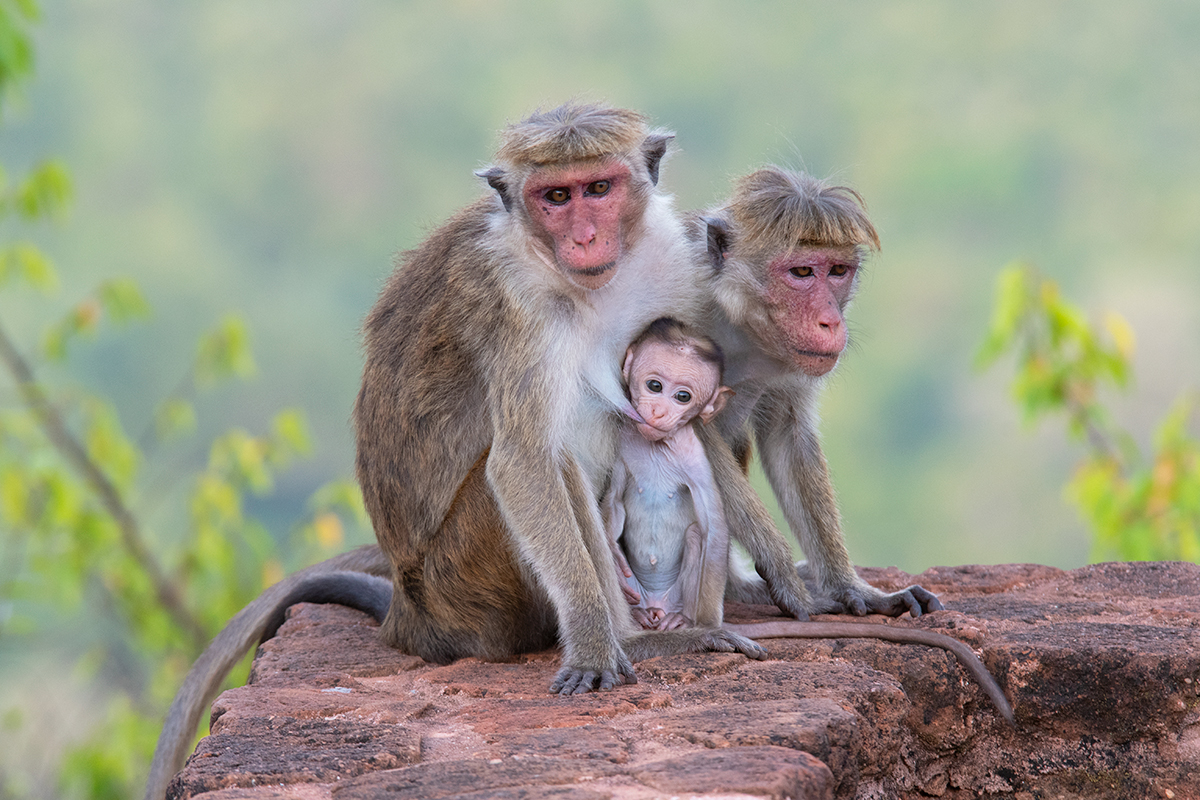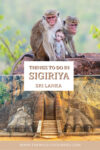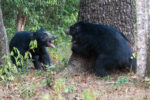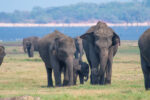Looking for things to do in Sigiriya? Enjoy seeing animals in the wild and visiting epic landscapes? Then this guide is for you
Sigiriya Rock may well be one of the most popular cultural destinations in Sri Lanka, but there are plenty of things to do in Sigiriya for nature and wildlife lovers as well.
We visited Sigiriya for 5 days as part of our Sri Lankan safari in search of the island’s wild cat species. So we visited all the cultural must-sees but spent more time exploring the wild side of Sigiriya.
And there are plenty of natural attractions in Sigiriya. From ancient volcanic vents to tranquil water reservoirs, from leaf monkeys to crocodiles, Sigiriya hides many surprises.
Great Place to Stay in Sigiriya for Wildlife Lovers
Before I talk about good places to visit to see wildlife around Sigiriya, I should mention a good place to stay. We picked Lahiru Homestay purely based on its impressive review score on booking.com. Little did we know that we’d have our best Fishing cat sighting right behind Lahiru’s house.
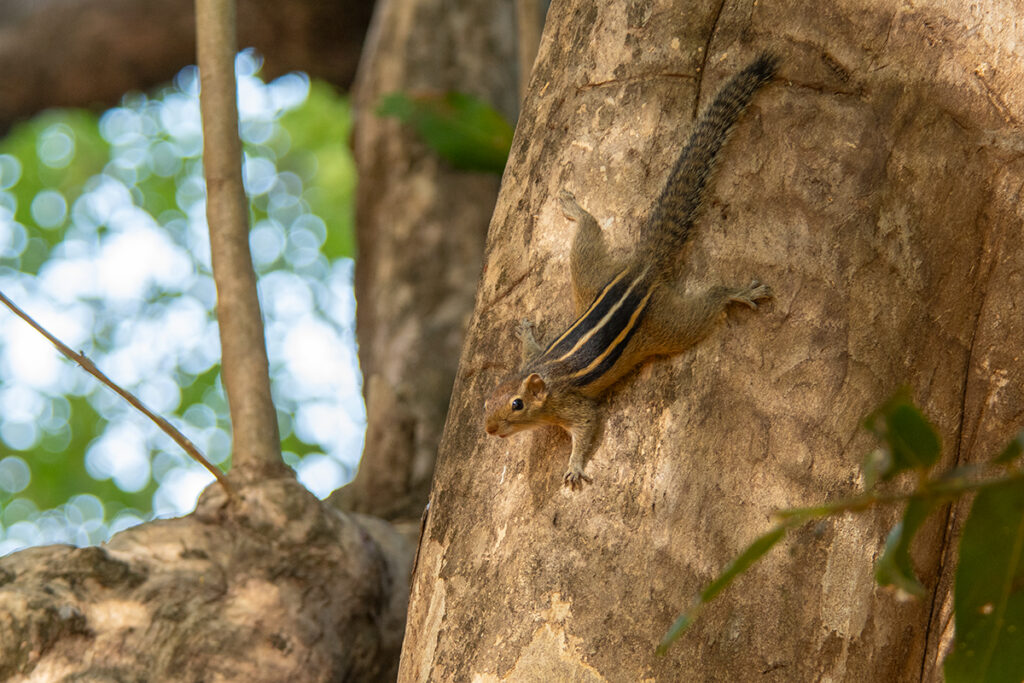
There is also a huge water reservoir behind the house with plenty of Marsh crocodiles and different species of frogs. And during the day we often had families of Gray langurs lounging in the trees around the house. Not to mention the Torque macaques and Palm squirrels.
Lahiru is also a man with unlimited connections and he helped us organise a shared safari to Kaudulla National Park. When he heard another couple was looking to book a safari, he connected us and we shared the cost of the jeep between the four of us.
Climb the Lion Rock for Sunset
Today Sri Lanka is not known for its volcanos, yet the island’s most popular tourist attraction – Sigiriya Rock (aka the Lion Rock) was formed in the hottest core of an ancient volcano.
Towering 180 meters above the green plain, the monolithic Sigiriya rock is a 2-billion-year-old volcanic plug. In the times of Sri Lanka’s volcanic past, hot molten lava from the bowels of the earth hardened inside the vent of the volcano, effectively plugging it shut.
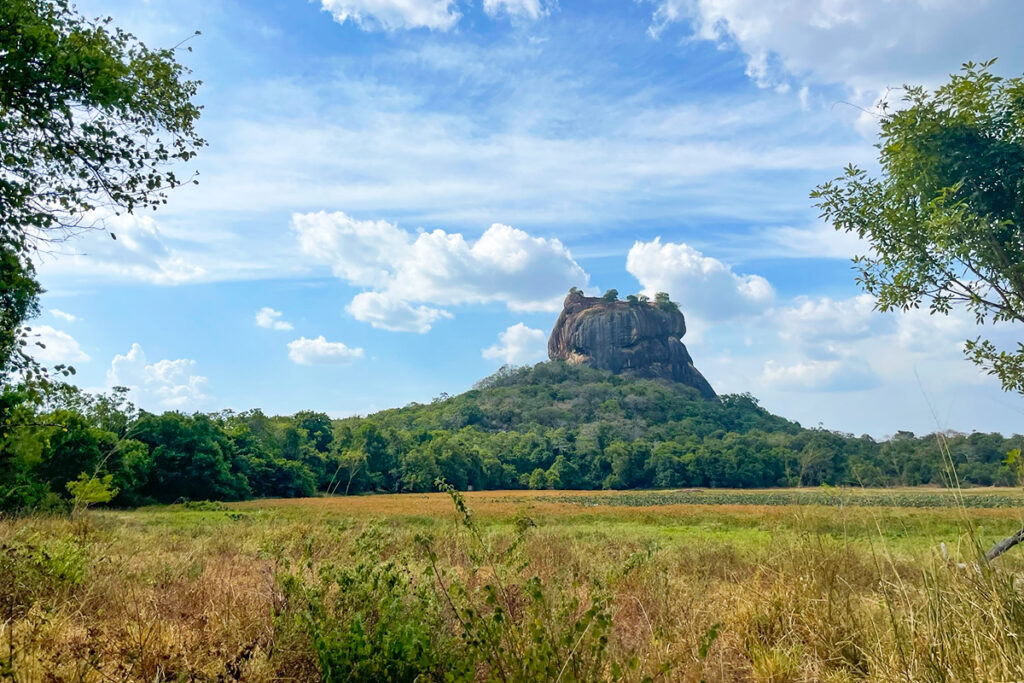
This solidified magma from the earth’s inner core is so hard that even 2 billion years of rain and wind could not erode it away, while the softer rock that made up the rest of the volcano is long gone, leaving behind a fertile plain.
Today, of all the things to do in Sigiriya, climbing Sigiriya Lion Rock is a must. Just imagine climbing the core of an ancient volcano made of solid granite!
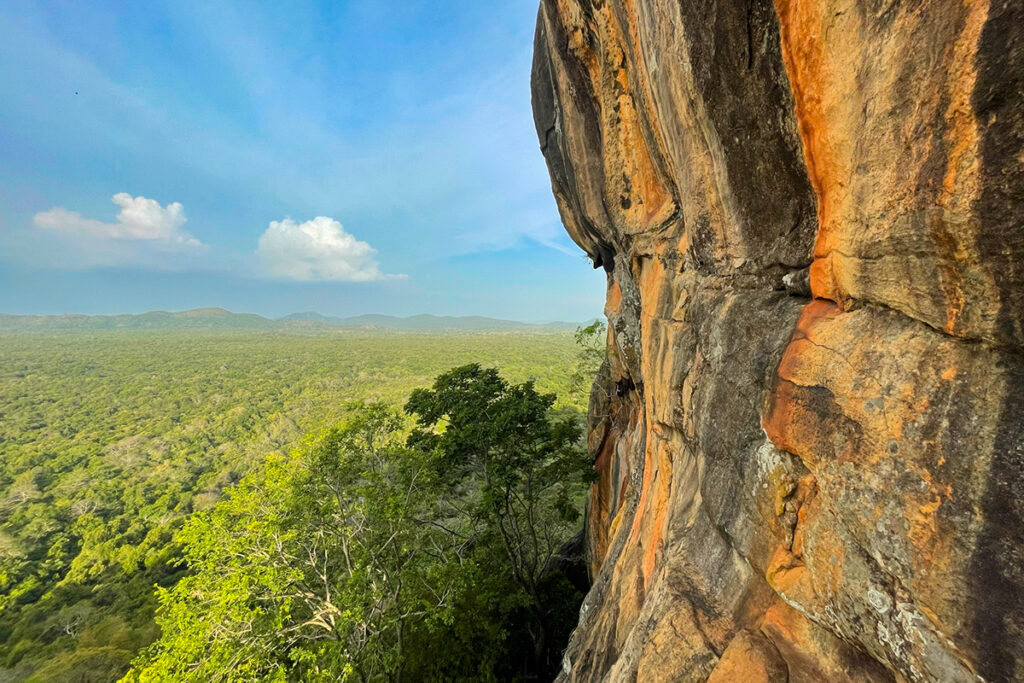
To make things even more interesting, there is a lot of culture to take in. When King Kashyapa (AD 477–495) arrived at what is now Sigiriya in the 5th century AD and saw the mammoth rock, he decided to build a palace and a fortress on its relatively flat summit.
The reason the rock appealed so much to King Kashyapa is that he was an illegitimate son of the King of Sri Lanka and in an effort to ascend to the throne, he had his father beheaded and his brother sent into exile. So it was most likely in fear of retribution that King Kashyapa sought such an inaccessible location for his royal citadel.
And if the 180-meter-high perch was not safe enough, Kasyapa had a protective moat built around the base of the rock, surrounded by an expansive water garden.
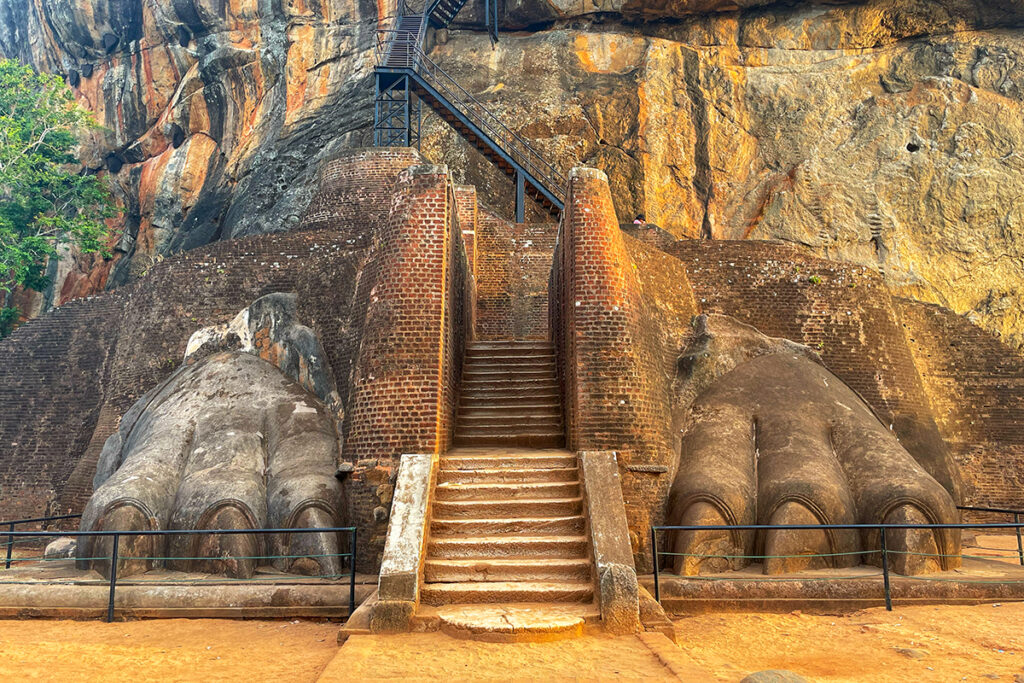
About halfway up the side of the rock, there is a small plateau where a massive gateway in the shape of a lion used to stand. All that’s now left are the lion’s feet (although they don’t look particularly feline). In any case, the rock is named after that gateway – the Lion Rock.
Thanks to this incredible feat of engineering (you’ll appreciate the effort of carrying construction materials to the top of the rock, as you climb the 1,200 steps yourself), that survives to this day, Sigiriya was declared a UNESCO World Heritage Site in 1982. It is one of Sri Lanka’s best-known cultural and historical sites, visited by up to a million people each year.
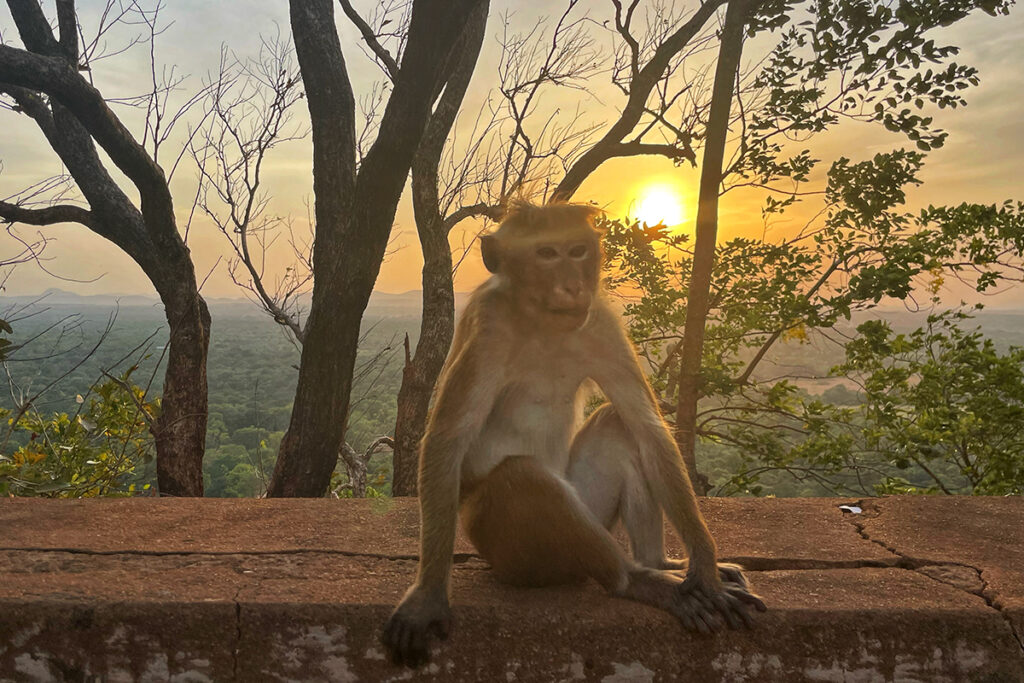
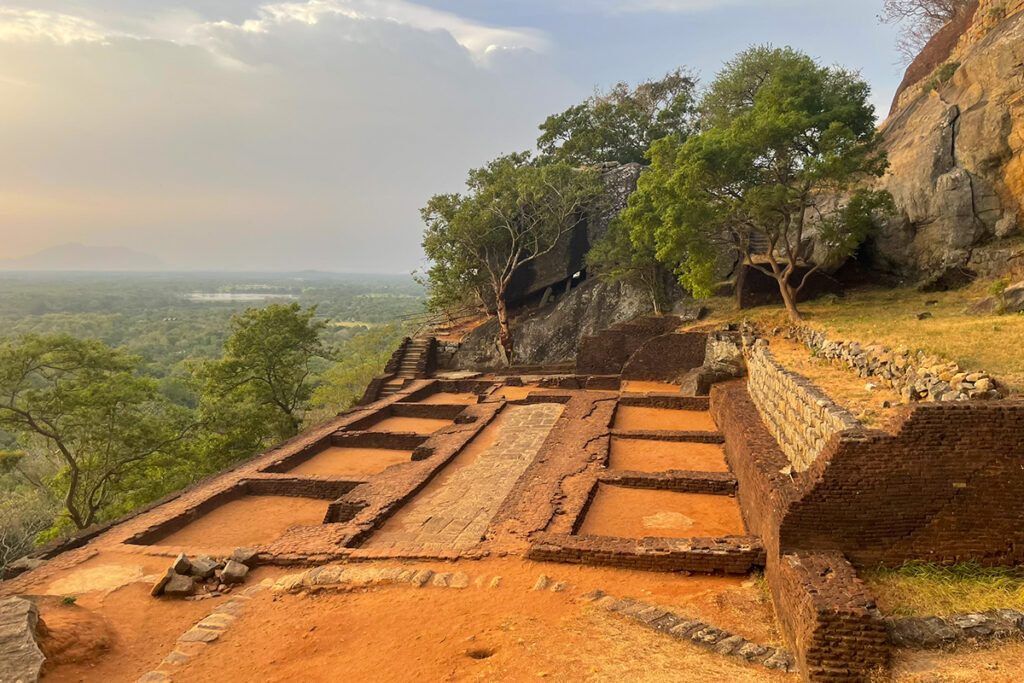
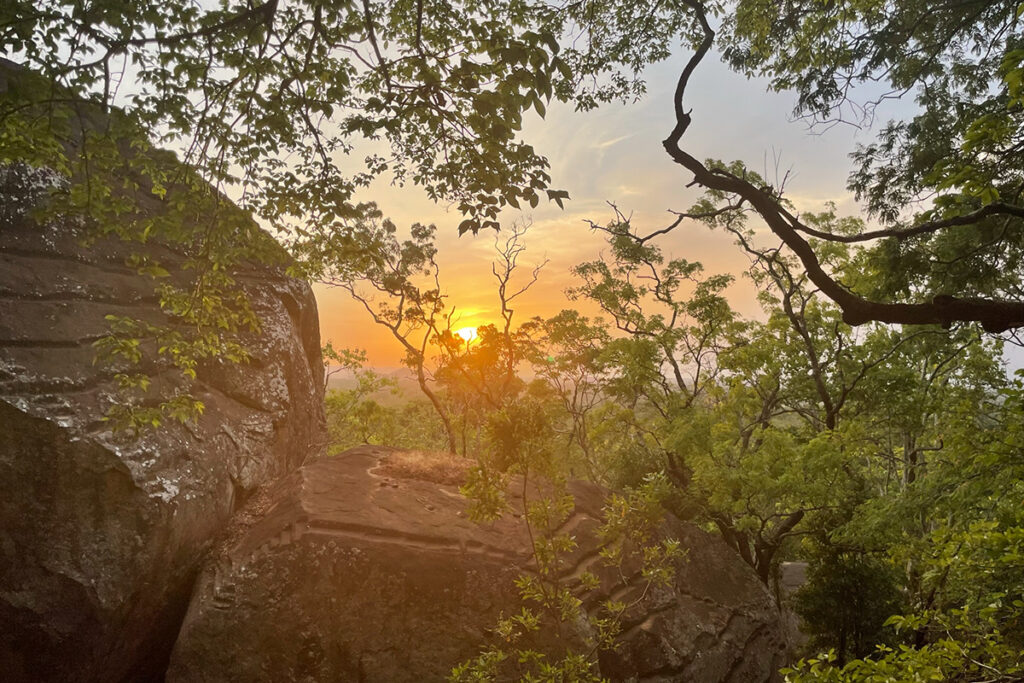
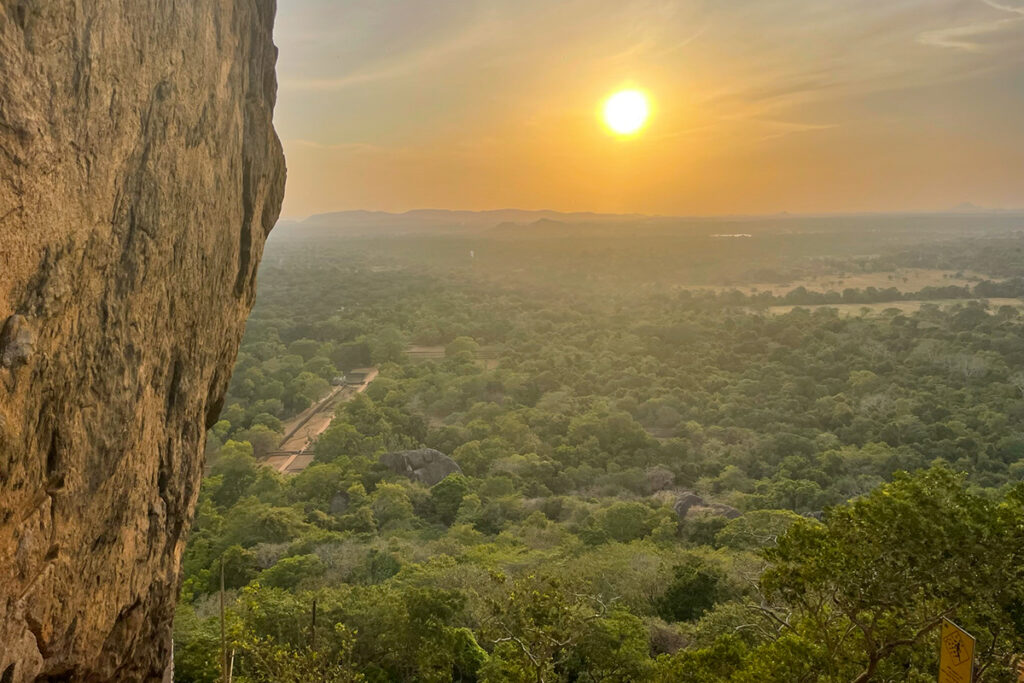
If you wish to avoid most of the crowds, the best time to climb Sigiriya Rock is first thing in the morning. Although, the climb opens at 6.30 am which means you will miss the sunrise.
You can, however, climb the rock for sunset. The climb takes between 1 and 2 hours to reach the top and another 30-45 minutes to climb back down. Make sure you start the climb before 5:30 pm if you plan to make it all the way to the top.
See Wildlife at the Lion Rock
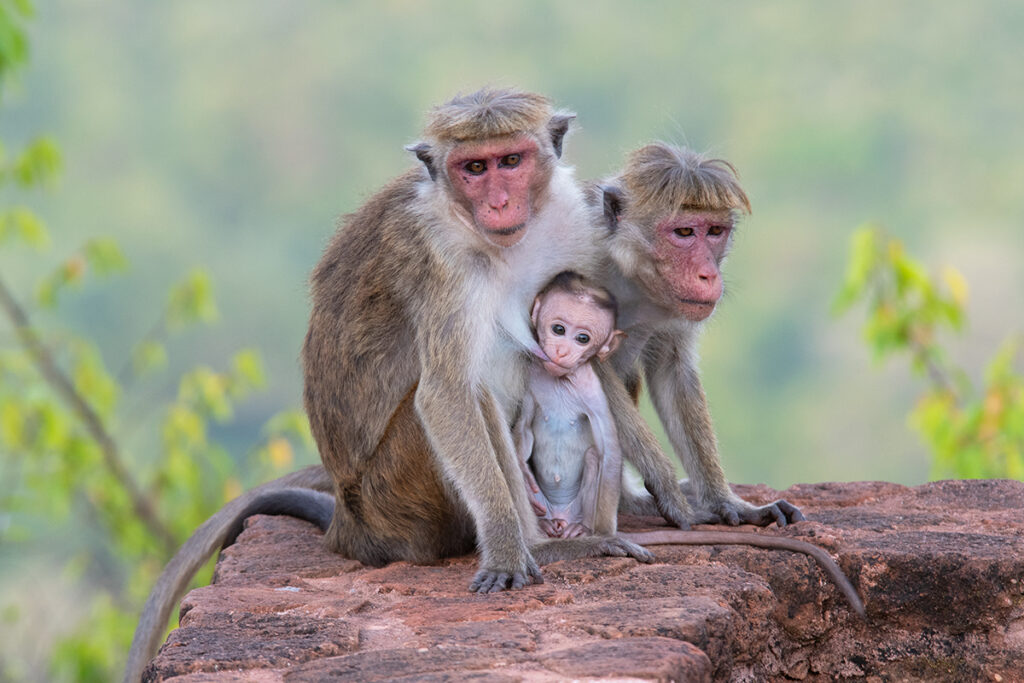
As popular as the Lion Rock is, not many people realise that the base of the rock is one of the best places to see monkeys in Sri Lanka. You can easily find 3 species of primates here.
Torque macaques are ubiquitous in Sri Lanka, and Sigiriya is no exception. There are seemingly as many macaques as humans around the Lion Rock.
While they look harmless and funny with their ridiculous hairdos, they can cause some trouble by grabbing whatever you leave lying around. So make sure to hold on to your cameras, phones and water bottles.
They tend to be more reserved on the Lion Rock itself. So if you want to watch the macaques, it’s best to leave it for your climb. They are a fun excuse to stop and take a break.
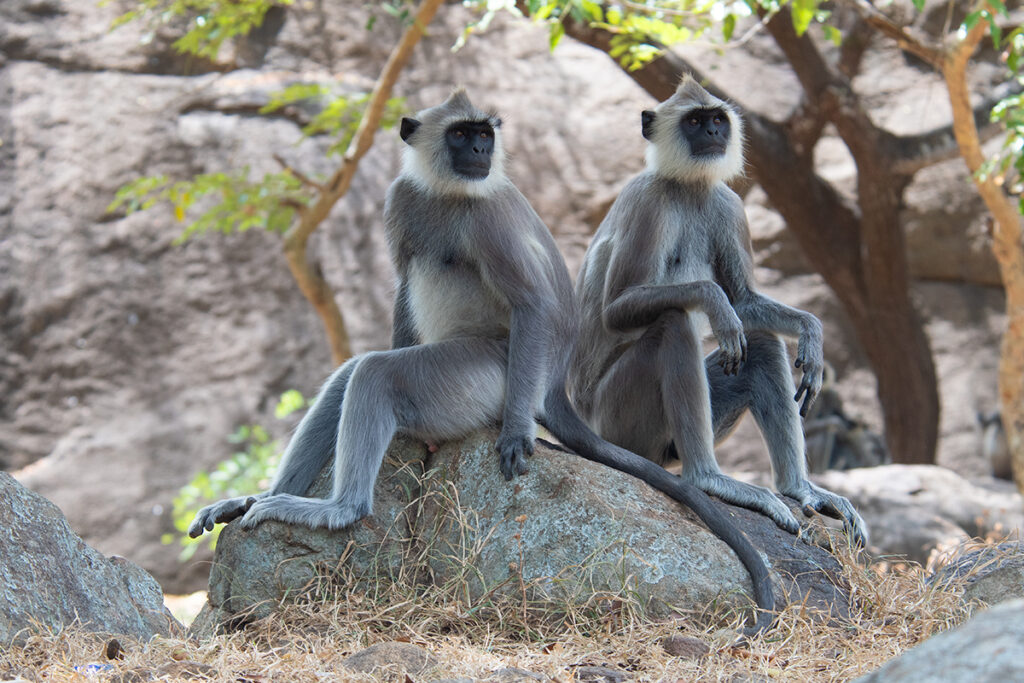
Another primate to look out for is a Gray langur. They live in troops so you are likely to see quite a few of them once you find them.
The area outside the moat, between the museum where you buy your tickets, and the tourist entrance is the best place to look for them. The forest at the base of the rock is also good.
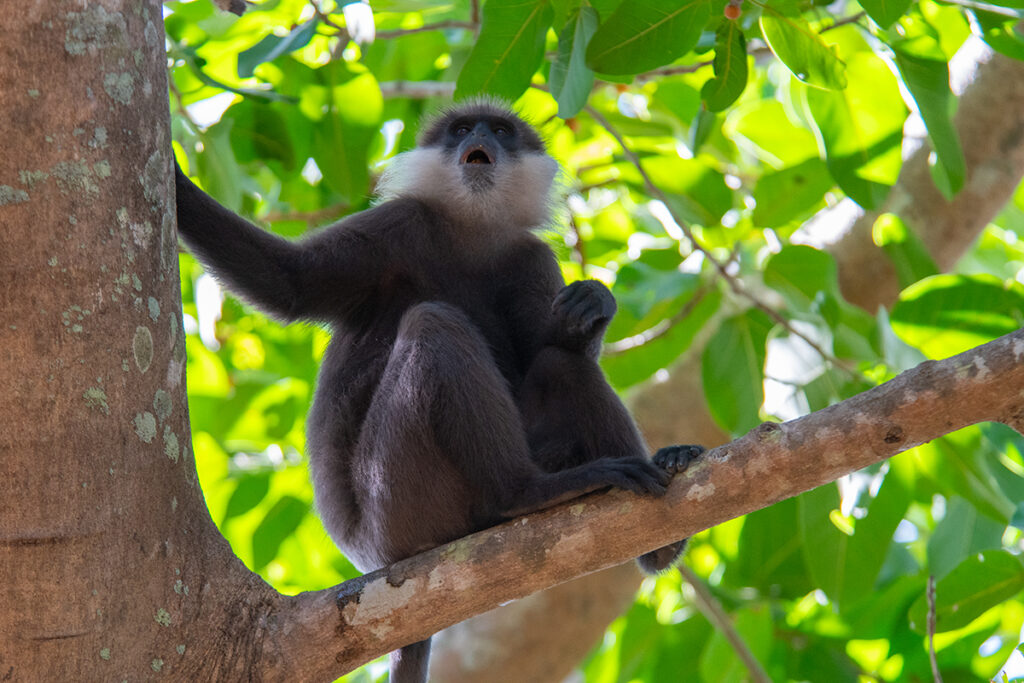
The more elusive primate at the Lion Rock is the Purple-faced leaf monkey or Purple-faced langur. While the macaques and Gray languors are very common across Sri Lanka, the Purple-faced leaf monkey is Endangered, mainly because it prefers a particular habitat type that’s quickly disappearing.
To find the leaf monkeys, look in the tree canopy just outside the moat, around the ‘cafe’. Once you find one, you should be able to locate a few of its troop mates. They would be sitting quietly among the leaves and branches nearby.
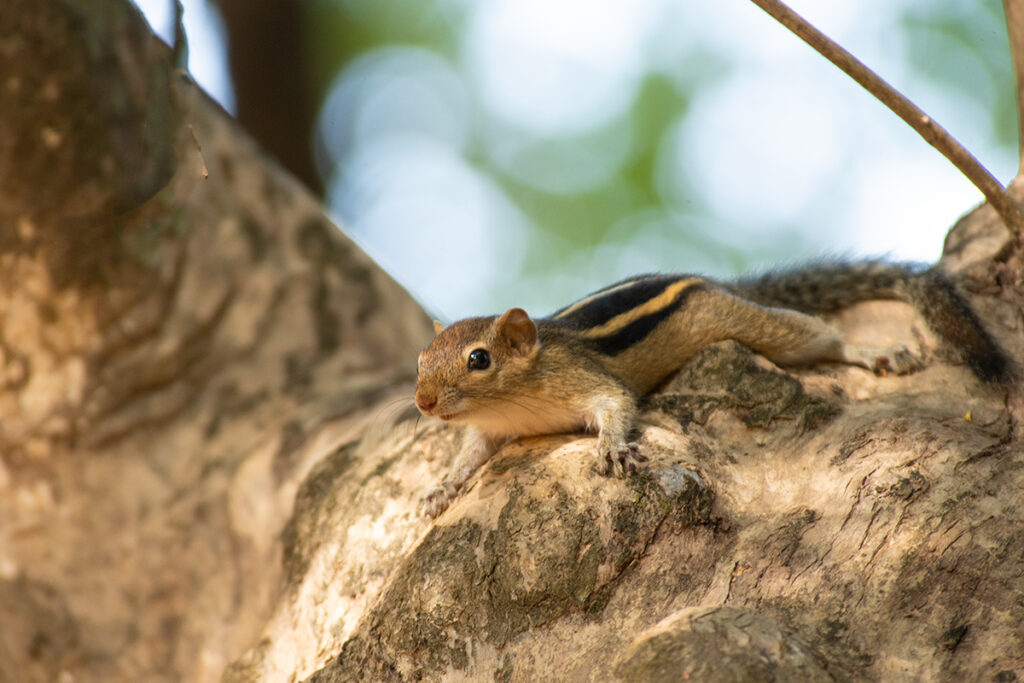
Monkeys are not the only type of animal you can see at Lion Rock. If you pay attention, you’ll definitely spot a few Palm squirrels racing up and down tree trunks.
They look like little chipmunks with the parallel dark stripes on their backs. They are very fast and seem to always be in motion, but if you stay quiet, you can approach them quite closely.
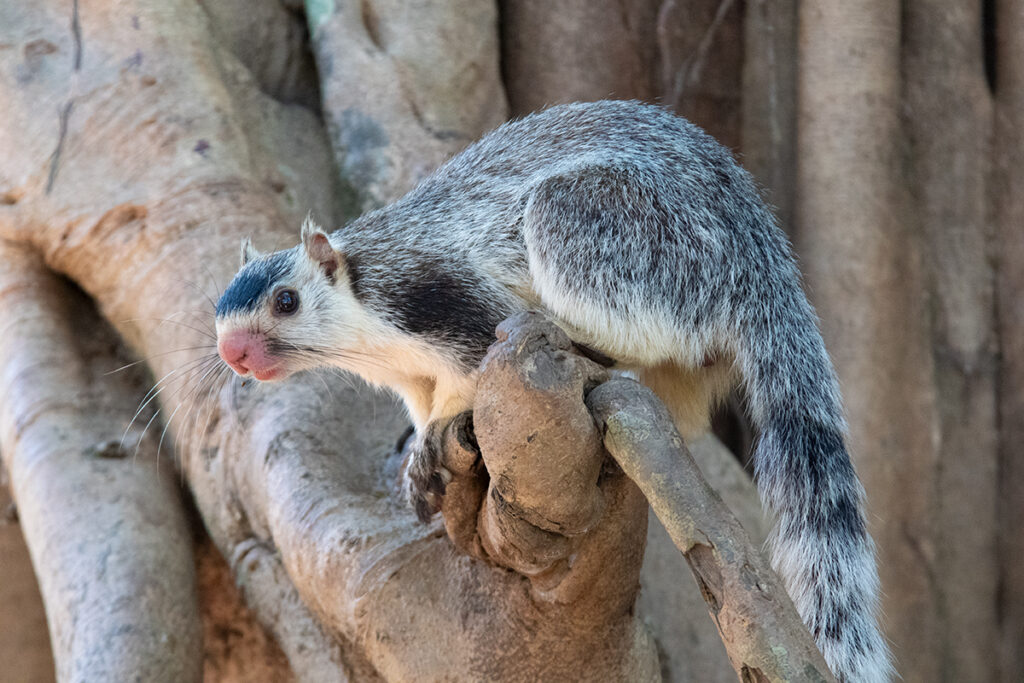
A much larger squirrel to spot here is the Grizzled Indian squirrel. For some obscure reason, this squirrel is the National Animal of Sri Lanka. It is a beautiful animal but it is not even native to the island.
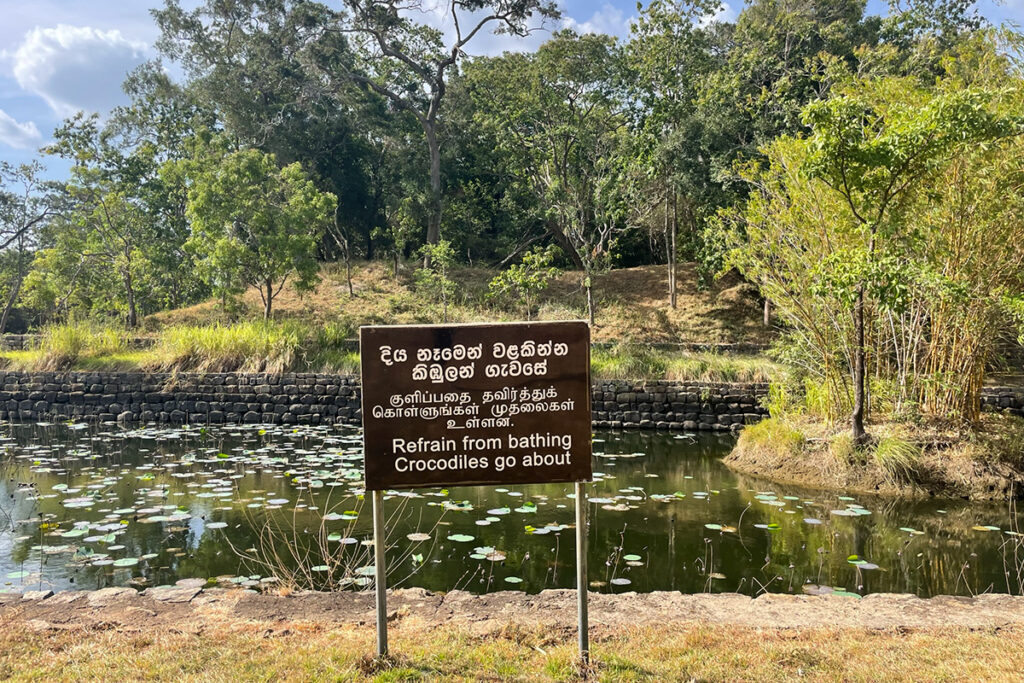
If you happen to visit the area at night (more on this at the end of the post), you might be lucky to spot the mean-looking Marsh crocodiles in the moat. But during the day you can still entertain yourself by reading the signs warning of their presence.
Watch Sri Lankan Elephants Gather
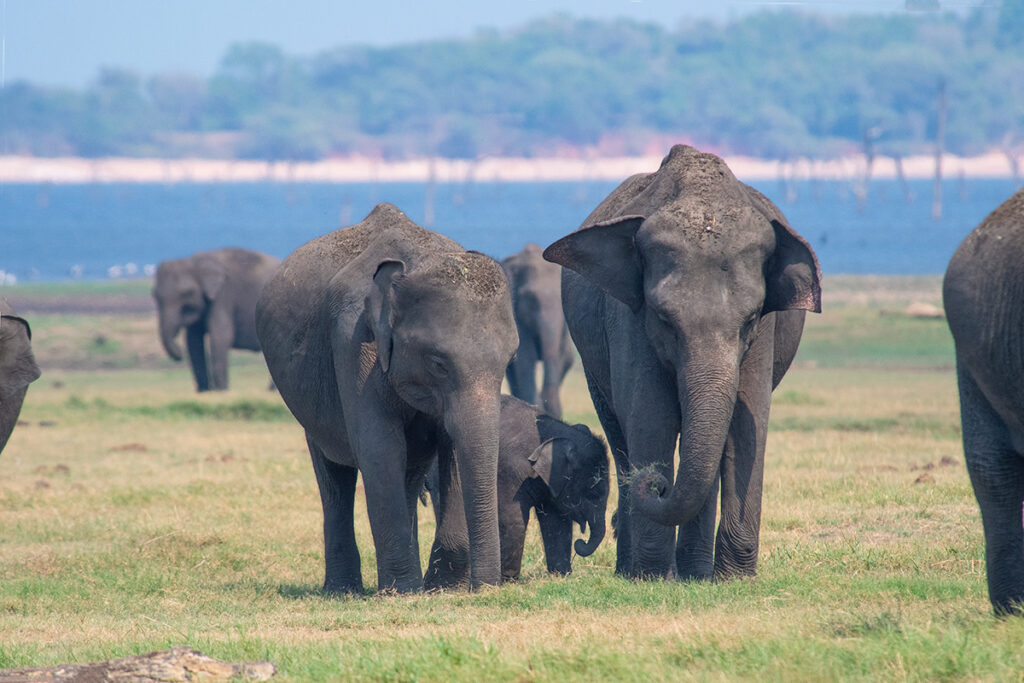
When it comes to wildlife spectacles, you should try to witness the Elephant Gathering in Minneria and Kaudulla National Parks. During the dry season (July to September) when most water sources dry out, elephants travel to the permanent reservoirs in these two parks.
They travel across the countryside and cross highways to get her in their hundreds in the event known as The Great Gathering. It is not uncommon for 200-300 elephants to be gathered around a single reservoir.
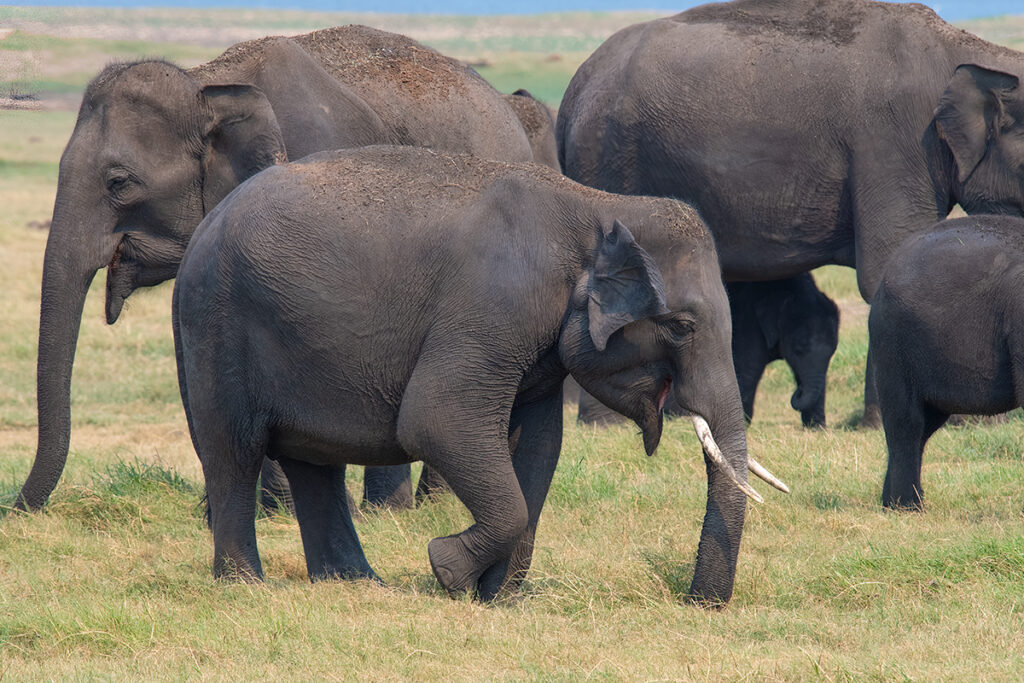
And it is not just the water that attracts the elephants. As the reservoirs begin to dry up and water retreats, it leaves a carpet of fresh green grass in its wake. Elephants come as much to feast on fresh grass as to be near a water source.
Watching a large herd of elephants slowly wade into the reservoir, take trunkfuls of water and splash it onto themselves is what the Gathering is all about.
The Gathering is quite mobile and the elephants move between Minneria and Kaudulla National Parks. There is no way to predict where the gathering will be at any given point. One solution for this is to book a safari that will take you to the park of your choice. By the time you arrive in Sigiriya, the tour operators will know where the gathering is happening at that time.
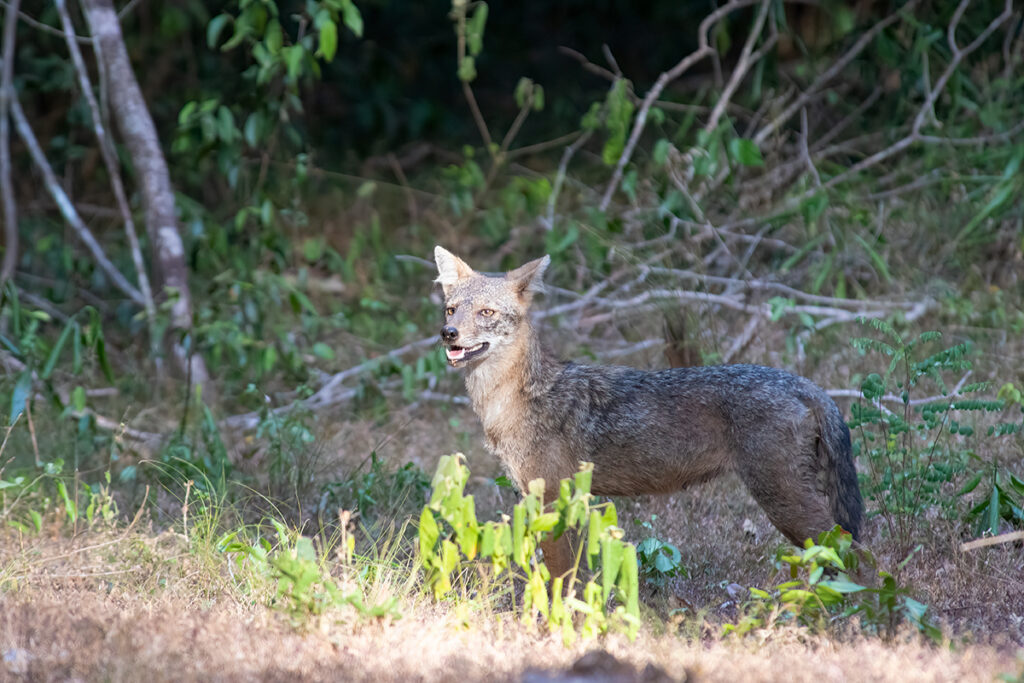
Elephants (and water buffalo) are of course not the only animals you can see in these national parks. In Minneria, you have a good chance to see Golden jackals, mongooses, Painted storks and Crested serpent eagles.
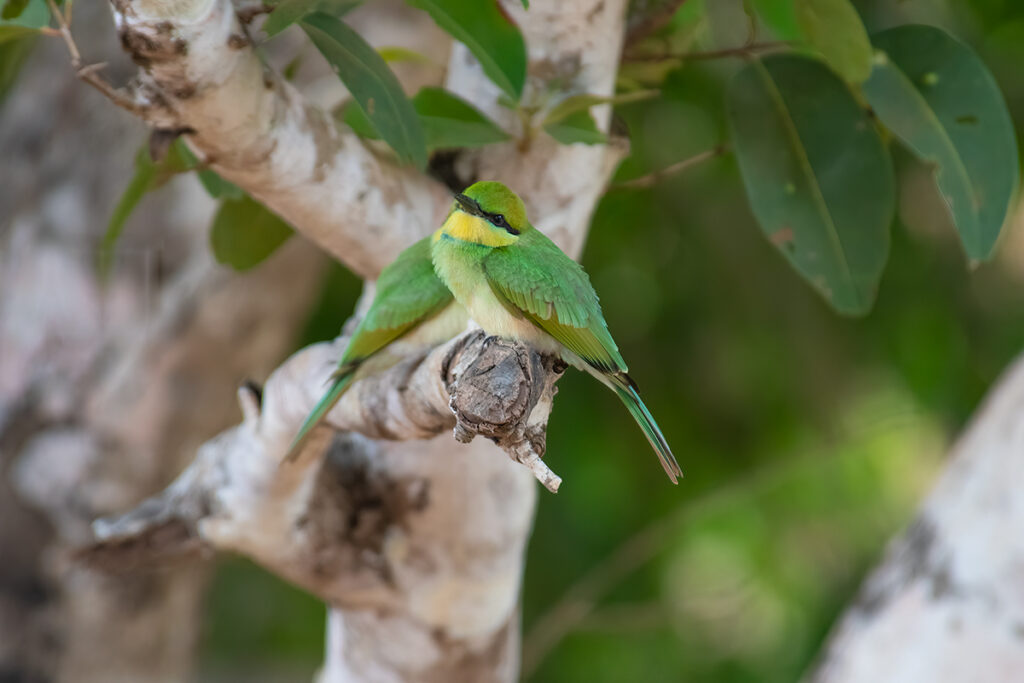
In Kaudulla, we saw a Ruddy mongoose, White-breasted kingfishes, a family of Green bee-eaters taking turns to feed their chick, Painted storks, Brahmini kites, Grey-headed fish eagle, Wooly-necked stork, Lesser Adjutant and Peackocks.
See the Slender Loris at Popham’s Arboretum
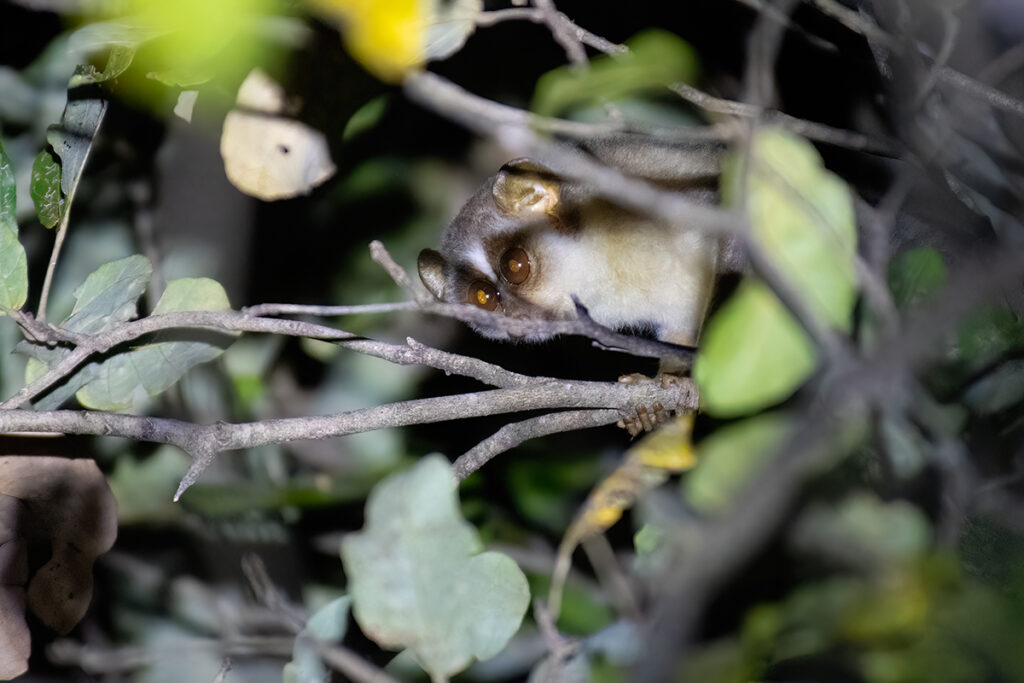
One of the most adorable Sri Lankan animals you can spot in the forests around Sigiriya is the tiny Grey slender loris. It has one of the most adorable faces in the animal kingdom.
While you can spot the loris on your own, to increase your chances, it’s best to join a tour to the nearby Popham’s Arboretum. The arboretum protects a patch of forest and is well-known for its thriving loris population.
You can also drive to the arboretum yourself, it’s only 4 km from Dambulla and 20km from Sigiriya.
Whichever way you arrive, your forest walk will start from the visitor centre. If you can, before the tour, ask the caretaker to show you a colony of False vampire bats in the stone tower next to the visitor centre.
The arboretum is also a good place to see the endemic Ceylon jungle fowl, which is a fancy name for a wild chicken.
The guided walk lasts 1 hour. You’ll be following the caretaker along the forest paths while he scans the trees with his spotlight.
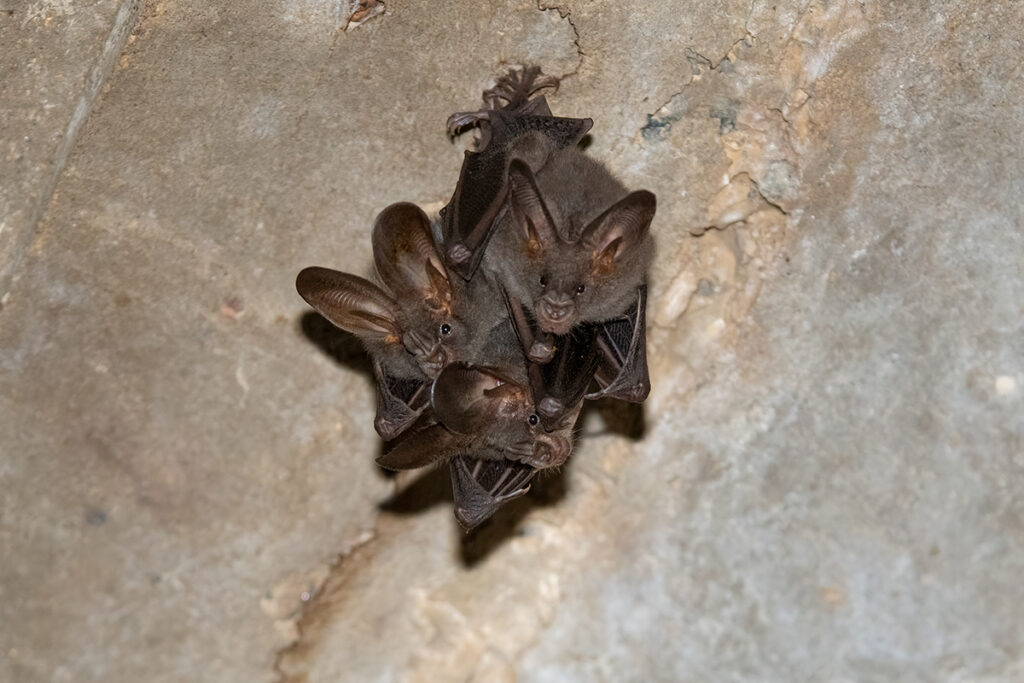
We saw Spotted deer and a Mouse deer while looking for the loris. And spotted two different slender lorises. We got to watch one of them for a few minutes as he examined us with his enormous eyes.
The second loris was on the move when we spotted it, and these guys move surprisingly fast.
We’ve seen slender lorises every night in our night drives around Sigiriya but never as close as we saw them in Popham’s Arboretum. I’m glad we visited and had a chance to see these tiny critters up close.
If you don’t have a chance to go spotlighting at night in Sigiriya, I highly recommend this tour to see the slender loris.
Climb Pindurangala Rock for Sunrise
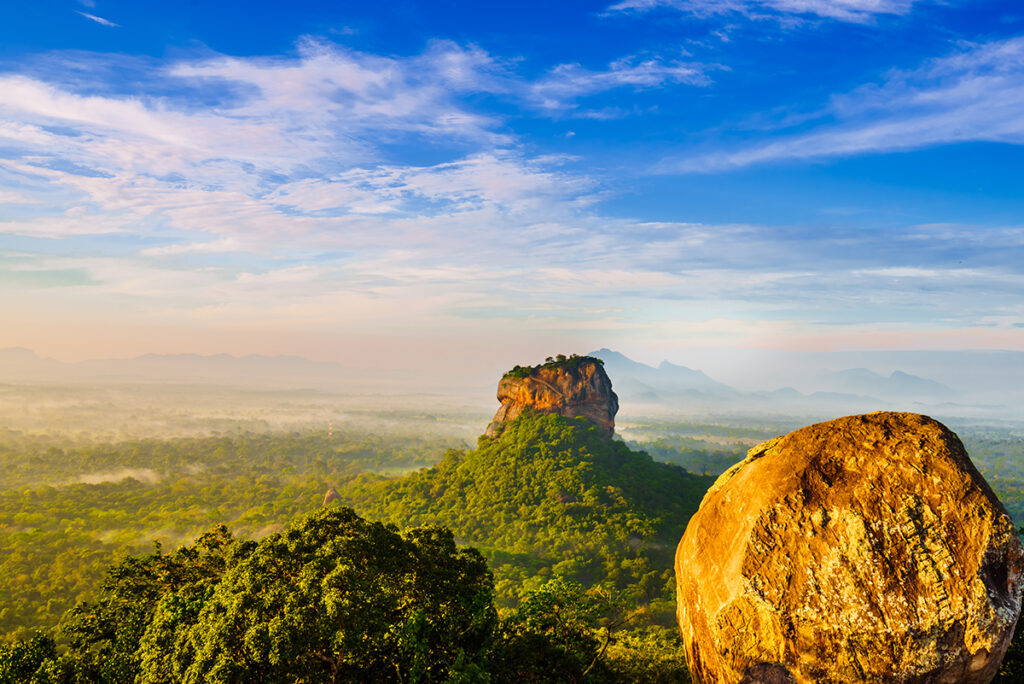
Less than a kilometre away, Pidurangala Rock is the core of another ancient volcano. Not as famous as Lion Rock, Pindurangala Rock has fantastic views of the surrounding countryside, including the Sigiriya Rock and even Minneraya and Kaudulla National Parks, some distance away.
The hike to the top of Pidurangala Rock is much more rugged than the Sigiriya Rock’s orderly stairs. You’ll be climbing over boulders and shimmeing between huge rocks as you make your way up.
The hike takes around 30 to 40 minutes to reach the summit, and the best time to do it is bright and early in the morning to watch the sunrise from the top of the rock. This means you’ll need to start climbing before 6 am.
If you are not too keen to climb on your own, your accommodation provider will most likely be able to arrange a guided hike for you. The sunrise climb to Pidurangala Rock is one of the most popular things to do in Sigiriya, so there are always guides available to accompany people up the rugged path.
If all else fails, see Lahiru at Lahiru Homestay. We quite often returned home at 4 am after our night drives and Lahiru was already getting up to get ready for the hike.
Look for Crocodiles in Sigiriya Moat at Night
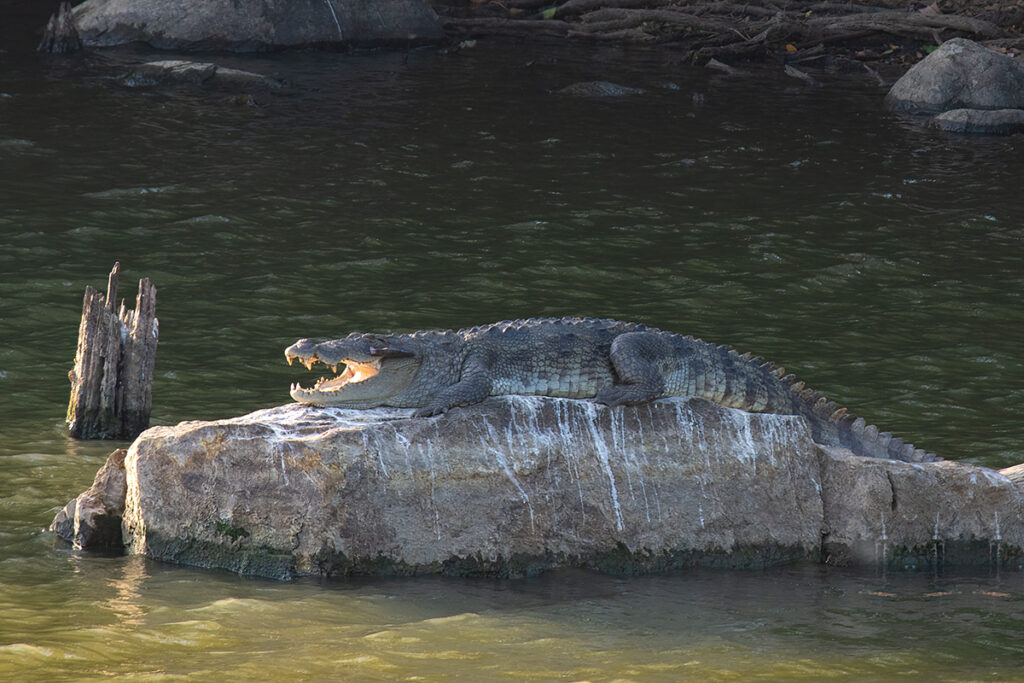
Finding crocodiles in the Sigiriya mote was an unexpected discovery for me. It is such a landlocked location that you just don’t think about large aquatic reptiles.
But come dark, and you can see dozens of Marsh crocodiles in various water reservoirs around Sigiriya. Also known as Muggers, these guys can grow to 5 meters long.
Sigiriya moat is a good place to go spotlighting to see them. Just pay attention when you are out and about at night in Sigiriya – this is when elephants move about and you don’t really want to disturb them.
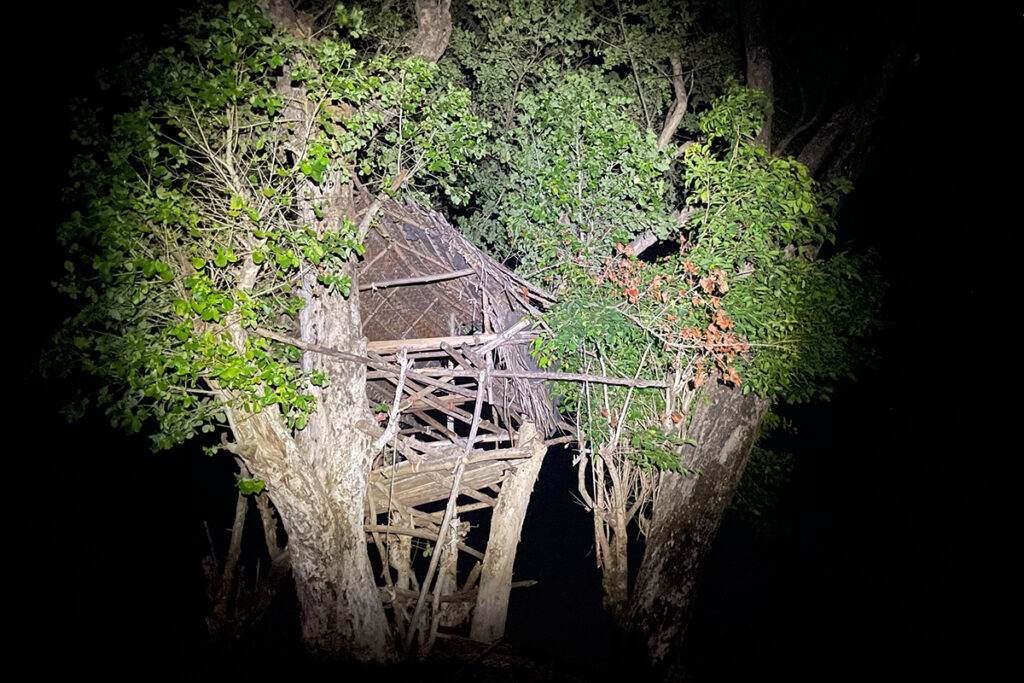
You’ll notice that most night-time shelters in Sigiriya are built as tree houses. This is to keep their occupants safe from the elephants. So farmers’ tents, and security guard ‘cabins’ are often located up in the trees.
The locals are very weary of encountering the elephants at night. Occasionally, people do get killed by them. So keep your eyes and ears open and if you encounter the elephants, give them plenty of space.
Go on a Night Drive
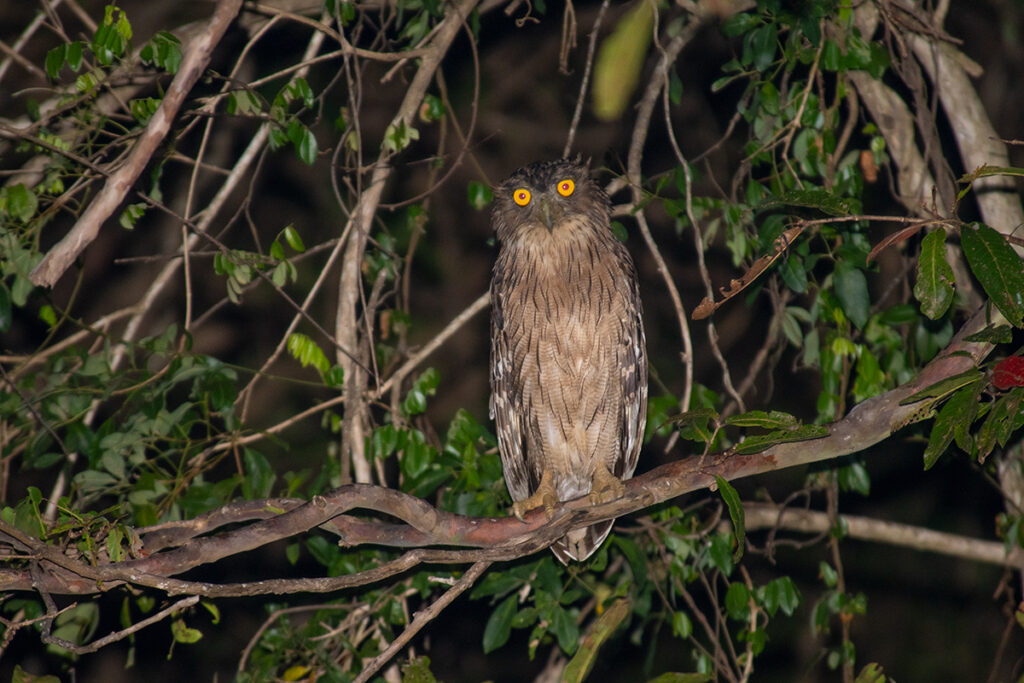
Much of Sigiriya’s wildlife is nocturnal, not just the crocodiles. If you have your own set of wheels, take a (slow) spotlighting drive in the farmland and forests around the village.
We were looking for wild cats and found Fishing cats and a Jungle cat, but this took a lot of dedicated effort. But some nocturnal animals are quite easy to see.
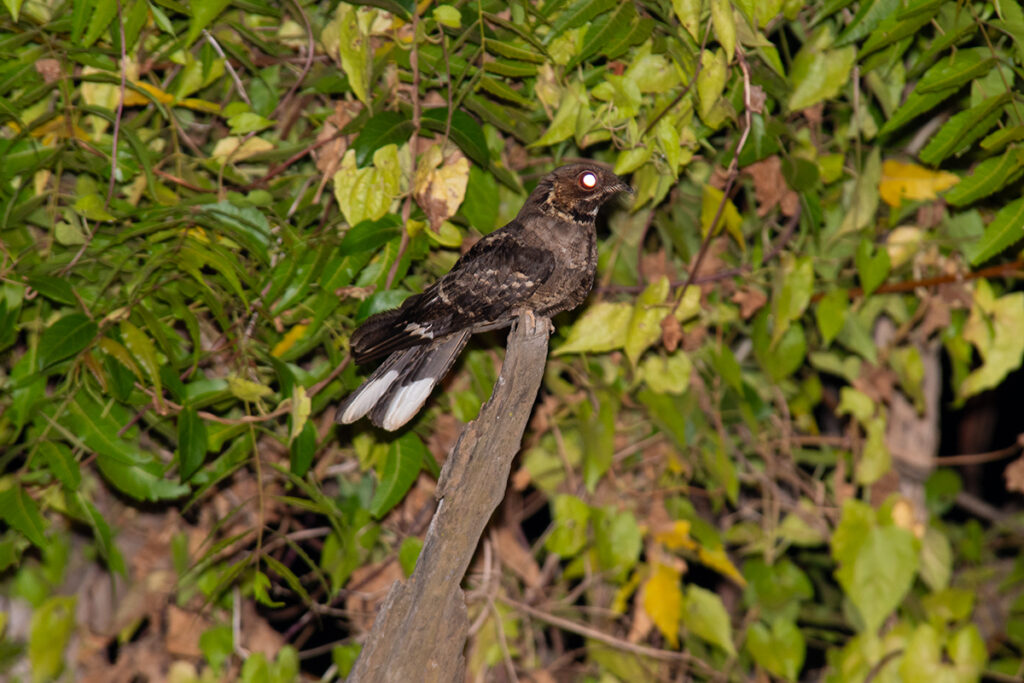
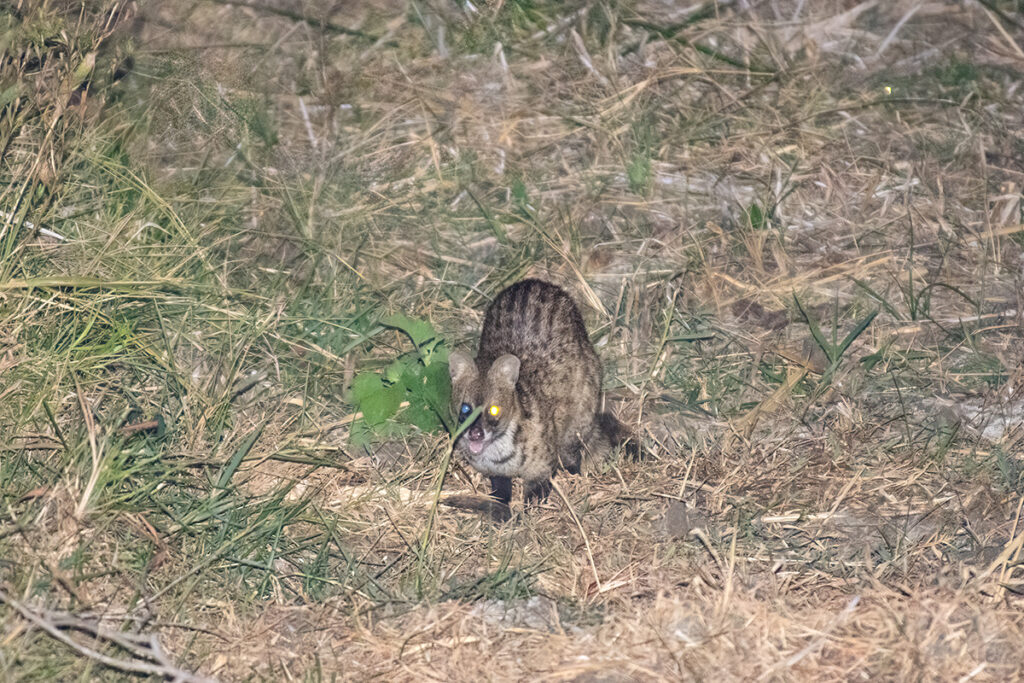
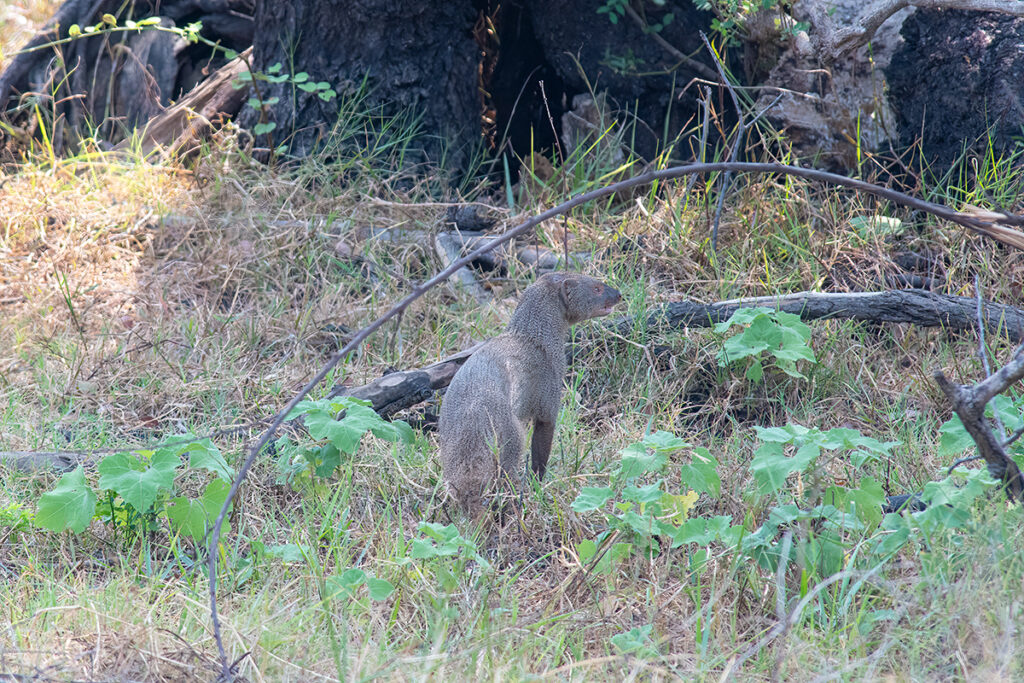
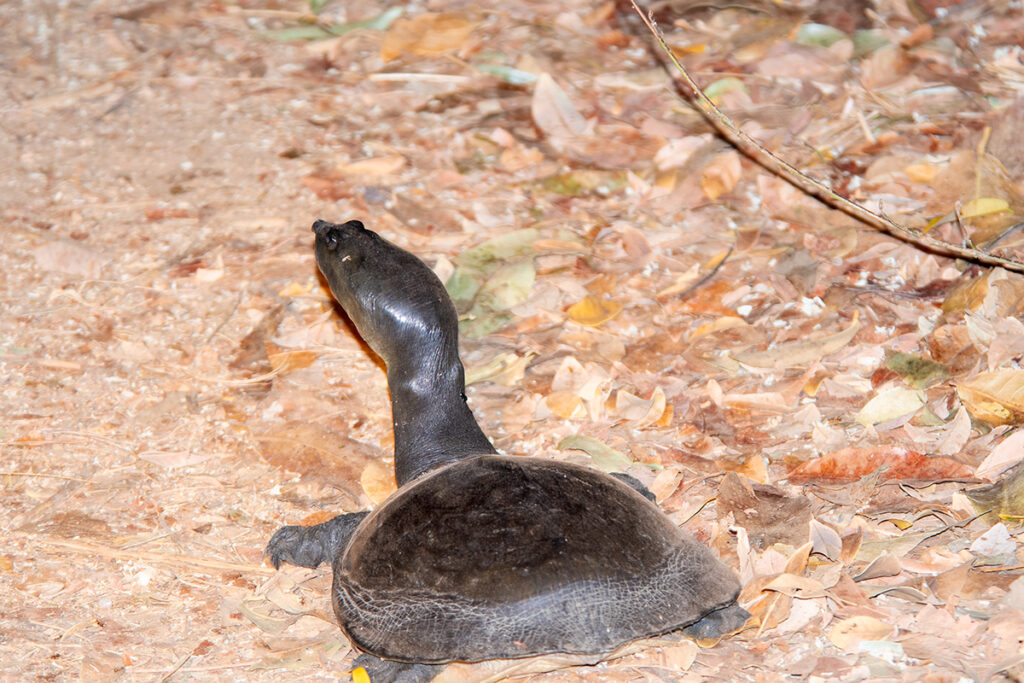
Keep an eye out for Spotted deer, Barking deer, the tiny Striped mouse deer, Crested porcupine, Black-necked hare, Ruddy mongoose, Grey mongoose, Palm civet and Small or ring-tailed civet.
Grey slender loris are quite common too, but they are often quite high up in the canopy. They don’t like bright lights, so remember not to point your torch right at them too much. If you do, they’ll simply move away, and you won’t get to watch them. And you’ll probably ruin their night by making them temporarily blind.
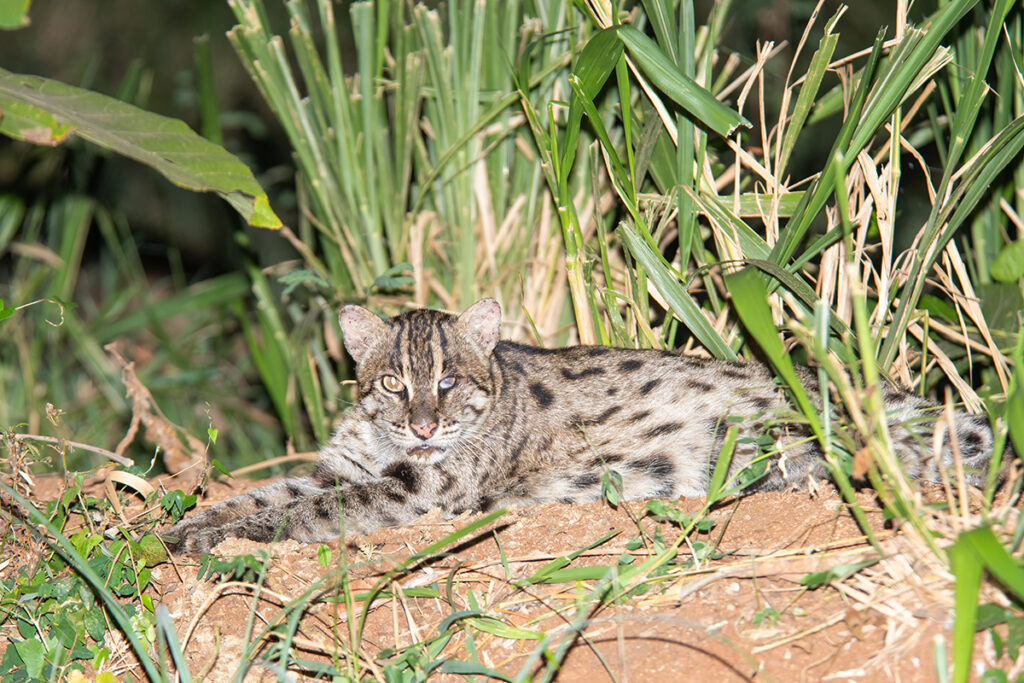
And there you have it – your guide to things to do in Sigiriya to explore its wild side. Between the National Parks, volcanic rocks and abundant wildlife – Sigiriya is a fabulous nature destination.
More on Exploring Sri Lanka
- Wilpattu National Park Safari Guide, Sri Lanka 2024
- Things to Do in Sigiriya for Nature Lovers – Wild Sri Lanka
- Best Ethical Whale Watching in Mirissa: Tour Review
- Guide to Planning Sri Lankan Safari
- 17 Things to Do in Trincomalee in 2023: Beaches, Whales & Temples
- 11 Things to do in Mirissa: Whales, Beaches, and Coconut Palm Trees

